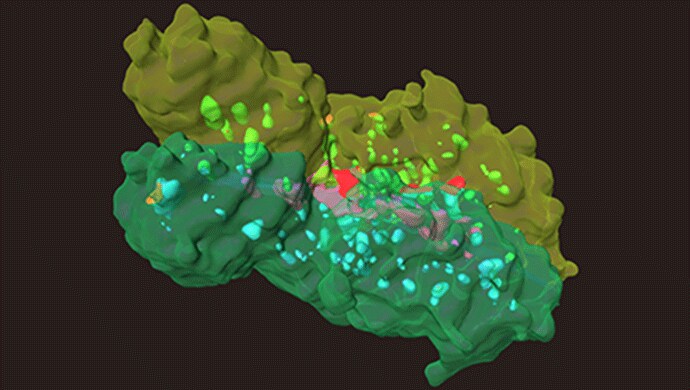Search
The London Centre for Nanotechnology uses Avizo Software to reveal structure of human chromosomes and nucleus in 3D
Customer Spotlight
By Prof. Ian Robinson, Dr. Bo Chen, London Centre for Nechnology, UCL and Tongji University
A team led by London Centre for Nanotechnology researchers, Prof. Ian Robinson and Dr. Bo Chen (now a professor at the Tongji University, Shanghai) used newly-developed serial block-face scanning electron microscopy (SBFSEM) and Thermo Scientific™ Avizo® Software, one dominant tool in 3D reconstructed image processing, to reveal the spatial structure of human chromosomes and nucleus quantitatively at high resolution of approximately 50 nm in three dimensions.
With the professionally aided processing and analysis, including the visualization features, skeletonization algorithm and quantitative modules from Avizo Software, Dr. Bo Chen and the team dove into the 3D structure of the nucleus and chromosomes. By using Avizo Software, the team dissected the nucleus and gained the information about its spatial organization. They found that the chromosomes are not only X-shaped, but also S-shaped and C- shaped, and that the larger chromosomes were more likely to be in an S-shape or C-shape, whereas the smaller chromosomes tend to be the familiar X-shape.
It also found that chromosomes are nonrandomly positioned in the prophase nucleus, with gene-rich chromosomes near the nuclear center and gene-poor ones near the periphery. The research team also deduced that the chromatin condenses locally into “visible” chromosomes during the cell cycle. Furthermore, during the chromatin condensation, the sister chromatid pairs were found not to be identical in morphology, but kept similar volumes.

With Avizo Software’s quantitative labeling analysis, the volume of the base pair was calculated to be 6.69 nm3, with the sister chromatids having a well-conserved diameter of about 765 nm in cylindrical shape regardless of their sizes. The research team also proposed a potential new method for identifying human chromosomes in three dimensions (based on the data of their 3D morphology and sizes that can be obtained from Avizo Software as well), but not conducting the multicolour fluorescence in situ hybridization (M-FISH) measurements as is traditionally done. The method can be used in the future to identify human chromosomes through 3D imaging approaches.
This work was supported by the Biotechnology and Biological Sciences Research Council (UK), the Engineering and Physical Sciences Research Council (UK) and partially by Tongji University (China).
It is a successful case that the paper authors applied the powerful and persuasive 3D image processing tool, Avizo Software, to the biological and biomaterials area. The research team has the capabilities to go further in the investigation of the condensation process of the chromatin by comparing the 3D structure of chromosomes and nuclei at the different stages of cell cycle using the newly established SBFSEM facility at the Tongji University, Shanghai.

The London Centre for Nanotechnology is a UK-based multidisciplinary enterprise operating at the forefront of science and technology. Their purpose is to solve global problems in information processing, healthcare, energy and environment through the application of nanoscience and nanotechnology.
About Amira-Avizo Software
Amira and Avizo Software are high-performance 3D software products for visualizing, analyzing, and understanding scientific and industrial data coming from all types of sources and modalities.
Text and data are courtesy of the London Centre for Nanotechnology